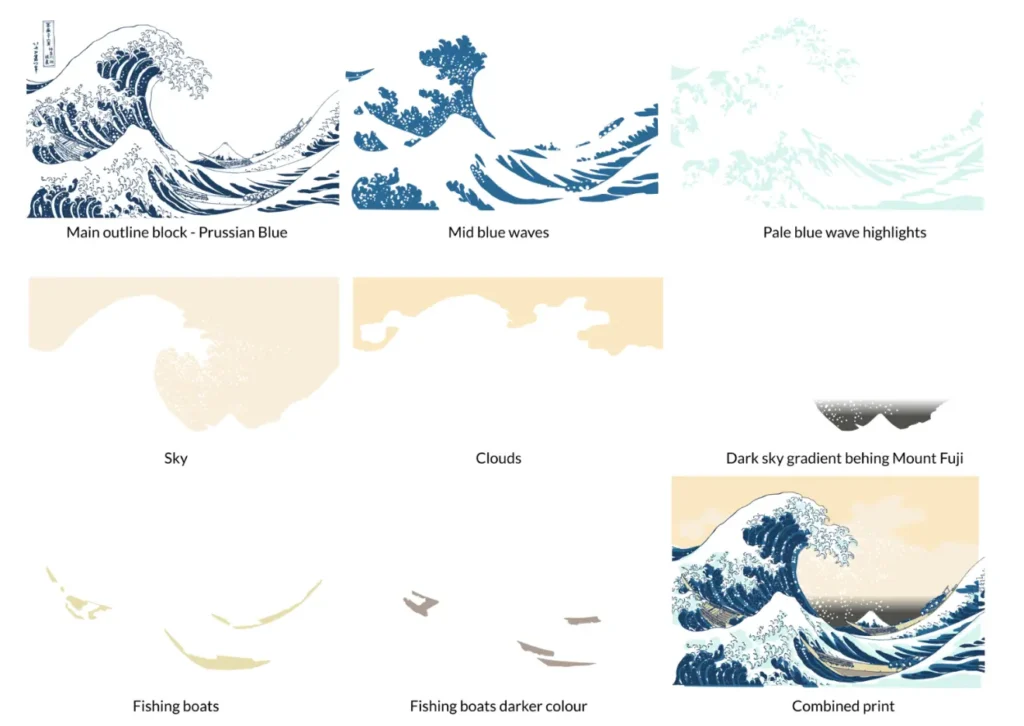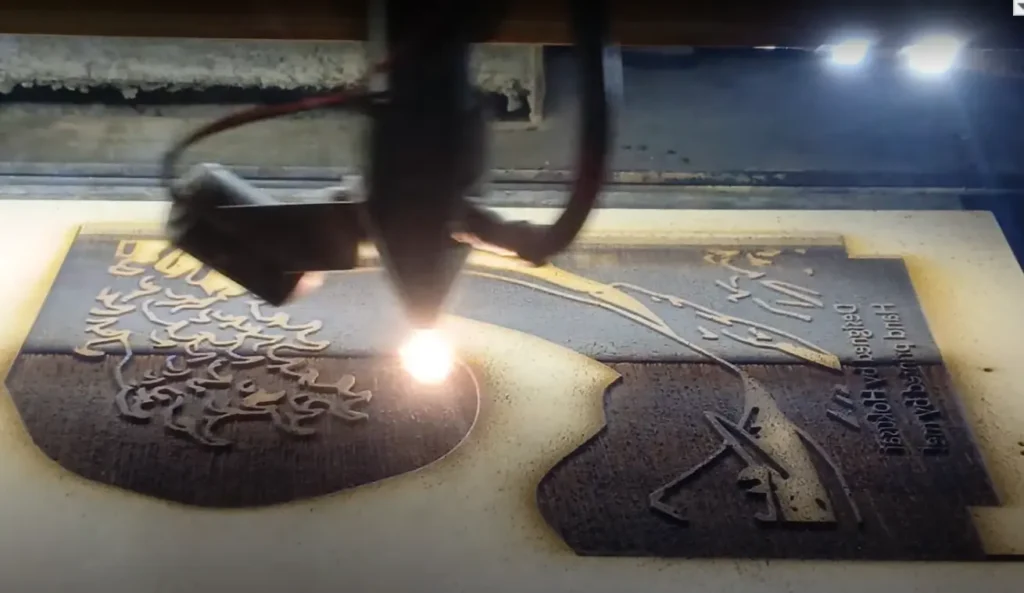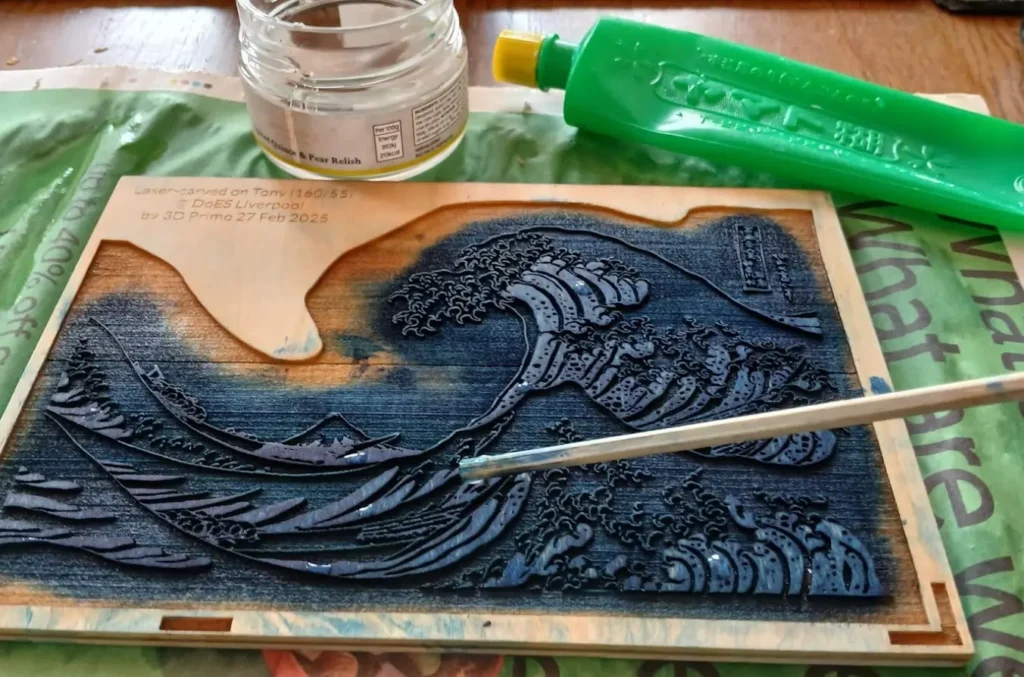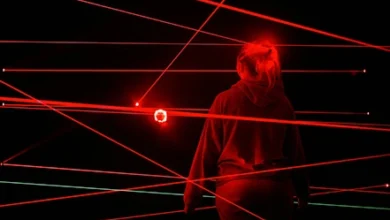
Making Waves With Andy Green: How One Liverpool Artist Is Bringing Hokusai’s Great Wave To Life
For artist and maker Andy Green, a chance experiment with a laser cutter at DoES Liverpool sparked an unexpected journey into the intricate world of Japanese woodblock printing. What began as a curiosity about laser-carving techniques soon became a deep dive into the time-honoured traditions of ukiyo-e, with Hokusai’s iconic The Great Wave off Kanagawa taking centre stage.
Now running hands-on workshops in Liverpool and beyond, Andy is offering people the rare chance to physically engage with one of the world’s most recognisable artworks—not just as observers, but as creators. From sourcing traditional washi paper in Tokyo to adapting centuries-old techniques with 21st-century tools, AG is merging old and new in a truly unique way. We spoke to him about what drew him to the craft, why The Great Wave remains so universally compelling, and what people can expect when they step up to the printing table.
Liverpool Noise: What initially drew you to woodblock printing, and why did you choose Hokusai’s Great Wave as the focal point of your workshops?
Andy Green: Although I’ve had a passing interest in Japanese woodblock printing since living in Tokyo in the 1990s, my active engagement with it has come about by happy accident relatively recently. A couple of years ago, having wrapped up a laser-cutting job early at DoES Liverpool, I wanted to see whether it was possible to carve out a woodblock by laser. A quick online search for Japanese ukiyo-e images in a compatible format turned up a number of Great Waves, so I just downloaded one and tried out a section of it on a scrap of spare fibreboard. The result exceeded expectation and although the MDF itself is totally unsuitable for transferring ink onto paper, I felt sufficiently encouraged to order some specialist woodblock plywood and have another go.

Before taking it further, I did consider some other beautiful ukiyo-e prints to reproduce, but eventually decided to stay with Hokusai’s Under the Great Wave off Kanagawa for a number of reasons:
Firstly, the image is instantly recognisable and immensely popular. A recent article in the Guardian describes the Great Wave as the defining image of our era and my experience so far seems to back that up. So many participants have their own personal memories, stories, artifacts, clothing, tattoos, fingernails and phone screensavers all bearing the familiar blue.
Secondly, it has a really engaging backstory. Though regarded as quintessentially Japanese, created during Japan’s era of self-imposed isolation, the work actually incorporates techniques and materials from other parts of the world.
Thirdly, The Great Wave uses a relatively small number of colours and requires only seven woodblocks, much fewer than some of the other well known prints.
And finally, as I am attempting to get up to speed with the woodblock printing process, much of the readily available know-how relates specifically to The Great Wave, so I can run with this straight away. Other works would have required much more leg work on my part. What is art if not theft, to paraphrase Picasso? As an example, check out this fascinating series of videos created by Tokyo-based woodblock printer David Bull, in which he documents the production of a new reproduction of The Great Wave.

You recently visited Japan and explored its traditional woodblock printing scene—what were the biggest takeaways from that trip?
I loved browsing the specialist stores in Tokyo to stock up on equipment (brushes, barens) and materials (inks, papers, nori rice paste). However, the undisputed highlight was attending a woodblock printing workshop run by master ukiyo-e carver Motoharu Asaka, one of the last few remaining to be traditionally trained in the craft. It was a real honour to print under expert tutelage using top quality equipment and materials, including Echizen washi paper.
Applying the ink to the woodblock sounds simple, but is anything but. Unlike the rollers (brayers) used for lino printing in the West, the Japanese use special horse or deer hair brushes to ink up the blocks. There are special techniques to achieve an even coverage without traces of brushstrokes. There are also hundreds of tiny holes in the Great Wave, and it is important to keep these clear of ink. There’s only so much you can learn in a short course, other than how much more there is to learn.
Positioning the paper onto the blocks also requires some dexterity. The prints from successive blocks for each colour have to line up – or register – precisely. To this end, there are a couple of notches or kento carved into the edges of the blocks.
Once the paper has been dropped face down onto the inked block, I was taught how to transfer the ink using a bamboo disk (baren) in a variety of circular and sweeping motions. It often requires a great deal of force to get an even coverage, so it doubles up as a bit of a workout. As the washi paper was strong but very thin, you can see the print develop from the reverse side. The paper took in the ink so easily and clearly and I was so delighted by the intensity and uniformity of the colours. In his appraisal, Asaka sensei remarked that he had never seen a print quite like mine, which I mistakenly took as a compliment ;-).

Can you tell us about the process of laser-carving replica woodblocks and how it compares to traditional hand-carving techniques?
Traditionally, Japanese ukiyo-e start off as black ink drawings on an early form of tracing paper. These would then be pasted onto a woodblock face down and the uninked areas carved out of the block using a range of knives, chisels and gouges to produce the master block. In the case of The Great Wave, this is the omo-han or main block that is used for the iconic Prussian blue. The blocks for the other colours are subsequently derived from the main block. As you can guess, woodblock carving is a highly skilled artform which takes decades of training and experience to master and hence one I’m highly unlikely to ever acquire.
By contrast, laser carving starts off by first selecting which of the myriad versions of the Great Wave to reproduce. Using Inkscape, I then trace the individual colours, each of which will form a separate block. I then load these files into Lightburn, the software that controls the laser machine, which burns (carves) out wood.
To date I have used shina-ply, the most widely used woodblock material in Japan. It has a really dense grain and is easy to carve with traditional tools, making it ideal for the job. Of course it wasn’t specifically designed for laser carving and whilst the results have certainly been good enough so far, I might yet find a better material for this new approach.

What you do is so unique. To our knowledge, there’s no one else doing this locally. Is that right, and how does it feel to be bringing such a rare craft to Liverpool?
I believe so. Although some work is being done in Japan, I’m pretty sure I’m the only one doing this in the UK. As such it feels quite an honour to be able to give people the opportunity of printing their very own Great Waves. So many people I have met have their own personal stories of why they love the work, and very often they’ll have some artefact with them bearing the artwork.
It also comes with a sense of responsibility. Learning the skills to become a professional woodblock printer takes years of training, dedication and experience in Japan, so obviously we have to manage expectations for those having their very first go at it. You can’t give someone a Stradivarius violin and expect them to knock out Vivaldi’s Four Seasons perfectly at the first attempt, and so it is with this craft. Nevertheless, the reaction when people peel the paper off the block to reveal their print is so often one of great joy and I’d like to think that Hokusai himself would approve.
What did you learn about Japanese printing papers, and how important are they to achieving an authentic result?
The Japanese have centuries of experience of papermaking and washi (lit. Japanese paper) is highly regarded and valued worldwide for printing, painting, calligraphy, origami and many other arts and crafts.
Woodblock printing places very high demands on the paper, which has to combine aesthetic delicacy with incredible strength to withstand the pressure applied as each colour is printed. Added to this, the paper needs to take very fine detail, so must not bleed, and has to have dimensional stability in order that colours from successive woodblocks register (align) perfectly. If the paper were to stretch or shrink between printing stages, the colours would misalign.
The highest quality handmade papers come from Echizen in Central Japan. I was fortunate enough to have a go at printing on one of these papers, which just seemed to know where the ink was meant to go. However, at this stage of our journey, these highest quality papers are perhaps a bit of an expensive luxury and it’s probably better to select papers that match the skill of the printer; there are many affordable machine made washi papers that do the job perfectly well.
What can people expect from one of your Great Wave taster sessions?
A unique experience. They will be physically interacting with one of the World’s great images in a way they could not with paintings like Sunfowers or Mona Lisa.
For the 10 minute drop-in sessions, people will just do a single block using the main Prussian Blue outline. For most, this is sufficient to get the exhilaration of printing their very own Hokusai. I demonstrate how to ink up the woodblock, how to correctly position the paper face down onto it and then how to transfer the ink using a bamboo burnishing disk known as a baren. It’s then time for the ‘big reveal’ as they gently peel the paper off the block to see what kind of print they have. I’ve yet to have anyone who was disappointed.
For those wanting a more in-depth experience, we run so-called ‘print parties’. These last between 2½ and 3 hours and we go through all the blocks to produce the multicoloured print. It’s fun to watch this famous image build up one colour at a time and it’s often the dark gray gradient behind Mount Fuji that proves the icing on the cake.

Have there been any particularly memorable reactions from participants trying woodblock printing for the first time?
Your reaction, Clare, was quite typical. You said you had no idea when you woke up that morning that you’d be printing your own Hokusai Great Wave that day and I could tell that you were delighted with the result. And when someone produces a particularly good print with an even covering of ink and nice, well-defined lines, the excitement is very clear to see.
Children of course tend to be more expressive and they’ll proudly wave around their Great Wave.
And perhaps the other memorable reaction was at last year’s Liverpool MakeFest at Central Library. A Japanese family had travelled up from London and popped into the event. Having their very first opportunity of printing The Great Wave was the very last thing they were expecting to do in Liverpool.
Finally, for those interested in trying woodblock printing at home, what advice or resources would you recommend?
In terms of advice, buckets of patience. Getting the woodblock, paper, ink, brush and baren all working together in perfect harmony does not happen at the first attempt, or even the hundredth. So start with realistic expectations.
All the materials and equipment can be purchased in the UK online, albeit at over twice the price they sell for in Japan. Start off with proofing papers. They’re inexpensive, work well and allow you to practice hundreds of prints without breaking the bank.
Always moisten the paper using a damp pack. Check out Laura Boswell’s brilliant series of videos for detailed guidance on this.
And if anyone is interested in creating a set of woodblocks from their very own design, we can help with that too.
Follow Andy Green @getme3dprinting for more info and updates.







